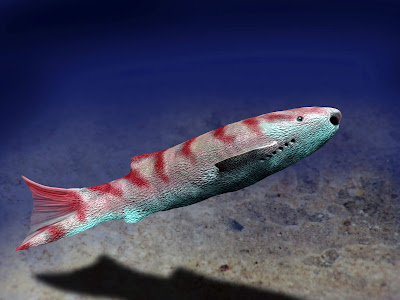從淺海追溯魚類的演化起源
魚類是地球上第一種脊椎動物,科學家認為牠們大約出現在4億8000萬年前。不過當時只有零星的魚類化石紀錄,只能找到微小的片段。然而,到了4億2000萬年前魚類化石紀錄卻變得相當豐富,有許多不同的魚類大量出現。
溝鱗魚(Bothriolepis)是化石紀錄中和某些最早有顎的脊椎動物相關的物種,這種披著裝甲的底棲性盾皮魚幾乎只生活在海岸地區。Lauren
Sallan和其同事發現這些魚類在擴散到其他棲地類型之前,在淺海就已經變得多樣化了。(圖片來源:Nobumichi
Tamura)
「嗯,這造就了一個懸而未解的問題:牠們之前在哪呢?」賓州大學的古生物學家 Lauren
Sallan說。「牠們之前躲在哪裡?又是在什麼樣的環境中誕生?」
Sallan、伯明罕大學的Ivan
Sansom以及其他科學家在發表於本周《科學》(Science)期刊的報告中,首度提出大量證據來回答這項問題。他們得出的答案指向了海岸附近,常見的樣貌為潮間帶或是淺水潟湖。
Phlebolepis生活於4億2500萬年前,這種流線型、鱗片細小的無頷魚悠游在珊瑚礁附近較深的潮間帶。(圖片來源:Nobumichi
Tamura)
「從我們現代的觀點來看,珊瑚礁對於魚類生物多樣性來說至關重要。因此我們推測魚類和珊瑚礁之間存在著十分古老的關係,可以回溯至魚類最初誕生的時候。」Sallan表示。「但數十年來,科學家持續在辛辛那提地拱(Cincinnati Arch )之類的地方尋找證據,結果卻是一無所獲。」
「反之,我們的研究顯示幾乎所有脊椎動物的主要分支――從最早無下頷的甲冑魚(armored jawless fish),一直到鯊魚及我們的祖先――都是發源在海岸附近,遠比珊瑚礁更接近陸地。而且,即使較早出現的族群已經散佈出去,海岸線附近仍然有新的族群出現。」
這項發現有助於解釋魚類化石紀錄的重要特徵,像是為什麼極少發現完整的早期魚類化石――這可能是因為淺海的波浪作用將它們給打成碎片。此外,這也讓科學家釐清為何隨著演化進行,許多魚類族群會從海水移居至淡水。牠們有些成為了淡水魚,其他則演化成最早的四足類――也就是陸生脊椎動物。
茄甲魚(Pituriaspis)是4億1千萬年前生存在澳洲的無頷魚中少見的一支。圖中的茄甲魚正在海岸線附近求偶。(圖片來源:Nobumichi
Tamura)
Sallan表示:「魚類移居淡水的時間通常比珊瑚礁還早,這幾乎是另一項顯示牠們在擴散之前必定生活在海岸附近的獨立證據。」
脊椎動物確切的發源地以及多樣化的地點一直是古生物學界熱烈討論的主題之一。此事件的關鍵發生在古生代中期,這時出土的某些化石族群訴說的故事顯示淡水環境或許是起源之地,但其他族群的故事卻可能把出生地指向開放海洋,還有一些則突然出現在別的棲地類型。讓情況更加撲朔迷離的是看似已經定案的無脊椎動物多樣性的起源故事:無脊椎動物在珊瑚礁附近變得多樣化,這些後代隨後開拓版圖至更淺或更深的水層。
Sallan、Sansom和合作科學家決定利用大數據方法來探討這項關於脊椎動物的問題。
「化石紀錄有個絕佳特點是,通常我們找到魚類化石的地方就是牠們的生存環境。」Sallan說。「牠們所在的岩石告訴了我們牠們所處的環境樣貌:珊瑚礁、淺海、深海、河流還是湖泊。」
研究人員將環境背景結合了我們所知古生代中期(4億8千萬至3億6千萬年前)的脊椎動物系譜樹,建立的資料庫包含了2728筆有頷魚和無頷魚的早期化石紀錄。
Sallan說:「這筆資料確實相當龐大。」
頭甲魚(Cephalaspis) 是一種底棲性的無頷骨甲魚,大多生存在4億1500萬年前的淡水環境。牠們是第一批擁有成對附肢的魚類,就像我們的雙手。(圖片來源:Nobumichi
Tamura)
接著研究人員就能運用數學模擬方法重建出化石紀錄缺失的資訊,從而有根據地預測許多脊椎動物最早的祖先是出現在什麼類型的棲地當中。
「我們意外地發現脊椎動物起源自非常封閉的淺海環境。」Sallan表示。「而且牠們出現之後侷限在此環境中很長一段時間。」
「我們還不知道這些遠古的淺海環境擁有什麼特別之處,使得最早的魚類在此踏出演化的第一步。」Sansom補充。「但我們確信這些地方提供了演化『熱點』,使得豐富的多樣性得以出現。」
即使魚類最初只待在淺水環境,牠們卻已經產生出各式各樣的能力來適應與其他種類共享環境時發生的競爭。研究人員特別指出許多族群在當時就已經獲得某些特徵,使牠們之後散佈到更深的海域時對底棲生物或者自由游泳的生態適應良好。
在現代的魚類中也能看到類似的多樣化發生,比方說棘背魚(sticklebacks)就在相當近代從共同的祖先演化成底棲和自由游泳這兩種類型的生物。
然而,還沒有人對現生的脊椎動物進行類似的全面研究。「我們想要知道淺海環境今日是否依然向珊瑚礁灌輸新的生物。」Sallan說。「創造新型魚類的地點現在在哪?」
如果實情真是如此,那麼面對眼下全球各地的珊瑚礁大量死亡時我們可能還有些許慰藉。也許淺海仍在擔任魚類多樣性的搖籃,就算珊瑚礁棲地日漸消失,魚類多樣性還是可以維持下去。
Tracing the evolutionary
origins of fish to shallow ocean waters
The first vertebrates
on Earth were fish, and scientists believe they first appeared around 480
million years ago. But fossil records from this time are spotty, with only
small fragments identified. By 420 million years ago, however, the fossil
record blossoms, with a huge variety of fish species present en masse.
“It’s
been this ongoing question of, well, where were they?” says Lauren Sallan,
a paleobiologist at the University of Pennsylvania. “Where were they
hiding? What were their environmental origins?”
Sallan, Ivan
Sansom of the University of Birmingham, and colleagues are the first
to present a wealth of evidence to answer that question in a report out this
week in the journal Science. And the
answer, it seems, is near shore, the areas often described as the intertidal
zone, or shallow lagoons.
“In
modern conceptions, we see that coral reefs are so important for fish
biodiversity, so we assume there’s an ancient link between fishes and reefs
going back to the beginning,” says Sallan. “But decades of searching in places
like the Cincinnati Arch have come up empty.”
“Instead,
our work shows that almost every major vertebrate division, from the earliest
armored jawless fish all the way up through sharks and our own ancestors, all
started out right near the beach, far inshore of the reef. Even as older groups
spread out, newer groups were also appearing at the shoreline.”
The
findings help explain important features of the fossil record, such as why so
few early fish fossils are found intact; the wave action of the shallow ocean
area likely blasted them into tiny fragments. It also helps scientists make
sense of the fact that, over evolutionary time, many fish groups moved from ocean
water to freshwater, some becoming freshwater fish, while others evolved into
the earliest tetrapods, land-dwelling vertebrates.
“They often went to freshwater before the reefs,
which is almost an independent line of evidence that they would have had to
have been close to shore before doing so,” Sallan says.
Exactly where vertebrates originated and diversified
has been a hotly debated subject in paleontology. Certain groups of fossils from
this key period in the middle Paleozoic Era told one story—perhaps a freshwater
site of origin—while other groups may point to a birthplace in the open ocean,
and still others popped up in other habitat types. Further complicating
matters, the origin story of invertebrate biodiversity seems settled: They
diversified around coral reefs, their descendants subsequently striking out to
inhabit shallower or deeper waters.
Sallan, Sansom, and colleagues decided to
investigate the question for vertebrates using a big-data approach.
“The nice thing about the fossil record is that we
often find fishes in the context of where they live,” Sallan says. “The rock
that holds them tells us what their environment looked like, whether it was
reef, shallow water, deep water, a riverbed, or a lake.”
Bringing that environmental context together with
what was already known about the family tree relationships of vertebrates from
the middle Paleozoic, 480 to 360 million years ago, the researchers created a
database that involved 2,728 early records for jawed and jawless fishes.
“It’s a really huge new dataset,” says Sallan.
The team was then able to reconstruct the missing
information in the fossil record using mathematical modeling, allowing them to
make informed predictions about the habitat type in which the earliest
ancestors of various vertebrate groups emerged.
“For vertebrates, we find that they’re originating
in this unexpected, really restricted shallow area of the oceans,” Sallan says.
“And they stay in this limited area for a long time after they emerge.”
“We don’t yet know exactly what was special about
those early, shallow marine environments that enabled earliest fish to take
those first evolutionary steps,” adds Sansom, “but we do think they provided
evolutionary ‘hotspots’, responsible for generating this rich diversity.”
As they remained in the shallows, however, they
gained a variety of adaptations that enabled them to compete with the others in
a shared habitat. The researchers noted that many groups acquired traits that
made them well-suited for life either as bottom-dwellers, or for a free-swimming
ecology out in the ocean’s deeper waters.
A similar divergence has been seen in modern fish,
such as sticklebacks, which evolved a bottom-dwelling and a free-swimming form
from common ancestors in more recent times.
No one has done a similarly comprehensive study on
living vertebrate species, however. “One of the things we want to know is
whether these shallow waters are still the biological pump that is feeding the
reef,” Sallan says. “Where is the current site of innovation?”
If that were the case, there may be some small
consolation in the face of mass reef die-offs around the world; maybe shallow
waters will continue to be the cradle of diversification for fish, allowing
biodiversity to persist despite a paucity of reef habitat.
原始論文:Lauren Sallan, Matt Friedman, Robert S. Sansom,
Charlotte M. Bird, Ivan J. Sansom. The nearshore cradle of early
vertebrate diversification. Science, 2018 DOI: 10.1126/science.aar3689
引用自:University of Pennsylvania. "Tracing the evolutionary
origins of fish to shallow ocean waters."




沒有留言:
張貼留言